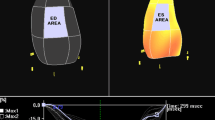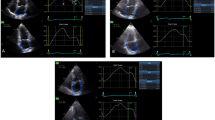Abstract
The purpose of our study was to test the usefulness of speckle-tracking two-dimensional echocardiography (in particular longitudinal strain and strain rate) in predicting the response to cardiac resynchronization therapy. The standard approach has been tissue Doppler-based echocardiographic imaging (TDI) has initially showed promising results in small clinical trials. However, recent larger, prospective randomized clinical trials (PROSPECT, ReTHINK) showed that TDI is inadequate to predict response from CRT in patients with heart failure. Altogether, these data suggest the need to identify alternative echocardiographic parameters to predict the response to CRT. We included 53 patients suffering from heart failure, who received CRT. TDI and two-dimensional speckle tracking imaging in addition to standard echocardiography were performed prior to CRT. The standard deviation of time to peak longitudinal strain in 12 LV segments (Tstrain-SD) and the standard deviation of time to the end of longitudinal systolic strain rate in six basal LV segments (Tsr-SD) were calculated. Standard echocardiography was performed 6 months after CRT. Patients were classified as echocardiographic responders if the LV end-systolic volume was reduced >15% compared with baseline volumes. No significant difference was seen in baseline Ts-SD, and Tstrain-SD between non-responders and responders. However, the Tsr-SD was much higher in responders than non-responders (95.9 ± 33.0% vs. 64.8 ± 39.6%, P < 0.05), and it showed a sensitivity of 73% and specificity of 65% for the defined echocardiographic response using a cutoff value of 70.7 ms. Our study demonstrates that longitudinal two-dimensional strain rate imaging is a promising potential echocardiographic parameter to predict benefit from CRT in patients with heart failure. This hypothesis needs to be further tested in prospective randomized clinical trials.





Similar content being viewed by others
References
Krum H (2005) The task force for the diagnosis and treatment of CHF of the European Society of Cardiology. Guidelines for the diagnosis and treatment of chronic heart failure: full text. Eur Heart J 26:24–72
Hunt SA, Abraham WT, Chin MH et al (2005) ACC/AHA 2005 guideline update for the diagnosis and management of chronic heart failure in the adult: a report of the American College of Cardiology/American Heart Association Task Force on Practice Guidelines (writing committee to update the 2001 guidelines for the evaluation and management of heart failure). Circulation 112:1888–1916
Bleeker GB, Bax JJ, Fung JW et al (2006) Clinical versus echocardiographic parameters to assess response to cardiac resynchronization therapy. Am J Cardiol 97:260–263
Yu CM, Fung WH, Lin H et al (2003) Predictors of left ventricular reverse remodeling after cardiac resynchronization therapy for heart failure secondary to idiopathic dilated or ischemic cardiomyopathy. Am J Cardiol 91:684–688
Bax JJ, Marwick TH, Molhoek SG et al (2003) Left ventricular dyssynchrony predicts benefit of cardiac resynchronization therapy in patients with end-stage heart failure before pacemaker implantation. Am J Cardiol 92:1238–1240
Yu CM, Fung WH, Zhang Q et al (2004) Tissue Doppler imaging is superior to strain rate imaging and postsystolic shortening in the prediction of reverse remodeling in both ischemic and nonischemic heart failure after cardiac resynchronization. Circulation 110:66–73
Sogaard P, Egeblad H, Kim WY et al (2002) Tissue Doppler imaging predicts improved systolic performance and reversed left ventricular remodeling during long-term cardiac resynchronization therapy. J Am Coll Cardiol 40:723–730
Gorcsan J III, Kanzaki H, Bazaz R et al (2004) Usefulness of echocardiographic tissue synchronization imaging to predict acute response to cardiac resynchronization therapy. Am J Cardiol 93:1178–1181
Suffoletto MS, Dohi K, Cannesson M et al (2006) Novel speckle-tracking radial strain from routine black-and-white echocardiographic images to quantify dyssynchrony and predict response to cardiac resynchronization therapy. Circulation 113:960–968
Zhang Q, Yu CM, Fung JW et al (2005) Assessment of the effect of cardiac resynchronization therapy on intraventricular mechanical synchronicity by regional volumetric changes. Am J Cardiol 95:126–129
Chung ES, Leon AR, Tavazzi L et al (2008) Results of the predictors of response to CRT (PROSPECT) trial. Circulation 117:2608–2616
De Boeck BWL, Meine M, Leenders GE et al (2008) Practical and conceptual limitations of tissue Doppler imaging to predict reverse remodelling in cardiac resynchronisation therapy. Eur J Heart Fail 10:281–290
White JA, Yee R, Yuan X et al (2006) Delayed enhancement magnetic resonance imaging predicts response to cardiac resynchronization therapy in patients with intraventricular dyssynchrony. J Am Coll Cardiol 48:1953–1960
Bleeker GB, Kaandorp TA, Lamb HJ et al (2006) Effect of posterolateral scar tissue on clinical and echocardiographic improvement after cardiac resynchronization therapy. Circulation 113:969–976
Ypenburg C, Roes SD, Bleeker GB et al (2007) Effect of total scar burden on contrast-enhanced magnetic resonance imaging on response to cardiac resynchronization therapy. Am J Cardiol 99:657–660
Breithardt OA, Stellbrink C, Herbots L et al (2003) Cardiac resynchronization therapy can reverse abnormal myocardial strain distribution in patients with heart failure and left bundle branch block. J Am Coll Cardiol 42:486–494
Prinzen FW, Hunter WC, Wyman BT, McVeigh ER (1999) Mapping of regional myocardial strain and work during ventricular pacing: experimental study using magnetic resonance imaging tagging. J Am Coll Cardiol 33:1735–1742
Amundsen BH, Helle-Valle T, Edvardsen T et al (2006) Noninvasive myocardial strain measurement by speckle tracking echocardiography: validation against sonomicrometry and tagged magnetic resonance imaging. J Am Coll Cardiol 47:789–793
Sutherland GR, Di Salvo G, Claus P et al (2004) Strain and strain rate imaging: a new clinical approach to quantifying regional myocardial function. J Am Soc Echocardiogr 17:788–802
Voigt JU, Flachskampf FA (2004) Strain and strain rate: new and clinically relevant echo parameters of regional myocardial function. Z Kardiol 93:249–258
Acknowledgments
We thank Dr. Dan Sorescu from Emory University for his critical reading of the manuscript. The National Natural Science Foundation of China (grant number: 30671999) support this study.
Author information
Authors and Affiliations
Corresponding author
Rights and permissions
About this article
Cite this article
Shi, H., Shu, X., Wang, F. et al. Longitudinal two-dimensional strain rate imaging: a potential approach to predict the response to cardiac resynchronization therapy. Int J Cardiovasc Imaging 25, 677–687 (2009). https://doi.org/10.1007/s10554-009-9480-z
Received:
Accepted:
Published:
Issue Date:
DOI: https://doi.org/10.1007/s10554-009-9480-z




